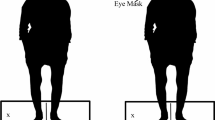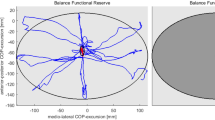Abstract
Purpose
Computerized posturography is the gold standard for balance assessment. Because of the great cost and dimensions of commercial equipments, low-cost and portable devices have been developed and validated, such as RombergLab, a software in open source term which works connected with a low-cost force platform. The objective of this study was to obtain normative posturography data using this software.
Methods
A multicentric prospective and descriptive study, with 350 healthy participants, was designed. Static postural stability (measured using the modified clinical test of sensory interaction on balance) was evaluated using the software connected to the force platform. Using the confidence ellipse area (CEA) in each condition, global equilibrium score (GES) was calculated and adjusted for significant variable factors using cluster analysis.
Results
Mean (SD) GES was 0.72 (0.22). Age (p < 0.01), height (p < 0.01) and recruitment center (p < 0.05) were found as influence factors for GES. Cluster analysis obtained 16 groups stratified by age and height. GES decreases with age and height (p < 0.005). No significant interaction of age nor height was found with GES in these clusters (p > 0.05). After correction for height and age, GES was no longer influenced by the recruitment center (p > 0.05).
Conclusions
With the introduction of the global equilibrium score values of the present study into the software, we consider RombergLab v1.3 a reference posturography tool for healthy individuals. Further studies are needed for validating it as a suitable instrumented test for screening between healthy and pathologic subjects and its reliability over time for the follow-up of patients.

Similar content being viewed by others
References
Sudarsky L (2001) Gait disorders: prevalence, morbidity, and etiology. Adv Neurol 87:111–117
Salzman B (2010) Gait and balance disorders in older adults. Am Fam Phys 82:61–69
Romberg MH (1846) Lehrbuch der Nervenkrankheiten des Menschen. Hirschwald, Berlin
Shumway-Cook A, Horak FB (1986) Assessing the influence of sensory interaction of balance. Suggestion from the field. Phys Ther 66:1548–1550
Horn LB, Scherer MR (2015) Measurement characteristics and clinical utility of the clinical test of sensory interaction on balance (CTSIB) and modified CTSIB in individuals with vestibular dysfunction. Arch Phys Med Rehabil 96:47–48. https://doi.org/10.1016/j.apmr.2015.04.003
Cohen H, Blatchly CA, Gombash L (1993) A study of the clinical test of sensory interaction and balance. Phys Ther 73:346–351
Baloh RW, Angeles L, Furman JMR (1989) Modern vestibular function testing. West J Med 150:58–67
Clark RA, Bryant AL, Pua Y et al (2010) Validity and reliability of the Nintendo Wii Balance Board for assessment of standing balance. Gait Posture. https://doi.org/10.1016/j.gaitpost.2009.11.012
Hubbard B, Pothier D, Hughes C, Rutka J (2012) A portable, low-cost system for posturography: a platform for longitudinal balance telemetry. J Otolaryngol Head Neck Surg 41:S31–S35. https://doi.org/10.2310/7070.2011.110082
Marchetti GF, Bellanca J, Whitney SL et al (2013) The development of an accelerometer-based measure of human upright static anterior-posterior postural sway under various sensory conditions: test–retest reliability, scoring and preliminary validity of the balance accelerometry measure (BAM). J Vestib Res Equilib Orientat 23:227–235. https://doi.org/10.3233/VES-130490
Bartlett HL, Ting LH, Bingham JT (2014) Accuracy of force and center of pressure measures of the Wii Balance Board. Gait Posture 39:224–228. https://doi.org/10.1016/j.gaitpost.2013.07.010
Leach JM, Mancini M, Peterka RJ et al (2014) Validating and calibrating the Nintendo Wii Balance Board to derive reliable center of pressure measures. Sensors (Switzerland) 14:18244–18267. https://doi.org/10.3390/s141018244
Park D-S, Lee G (2014) Validity and reliability of balance assessment software using the Nintendo Wii Balance Board: usability and validation. J Neuroeng Rehabil 11:2–8. https://doi.org/10.1186/1743-0003-11-99
Scaglioni-Solano P, Aragón-Vargas LF (2014) Validity and reliability of the Nintendo Wii Balance Board to assess standing balance and sensory integration in highly functional older adults. Int J Rehabil Res 37:138–143. https://doi.org/10.1097/MRR.0000000000000046
Pavan P, Cardaioli M, Ferri I et al (2014) A contribution to the validation of the Wii Balance Board for the assessment of standing balance. Eur J Sport Sci 15:600–605. https://doi.org/10.1080/17461391.2014.956801
Llorens R, Latorre J, Noé E, Keshner EA (2016) Posturography using the Wii Balance Board™. A feasibility study with healthy adults and adults post-stroke. Gait Posture 43:228–232. https://doi.org/10.1016/j.gaitpost.2015.10.002
Levy SS, Thralls KJ, Kviatkovsky SA (2016) Validity and reliability of a portable balance tracking system, BTrackS, in older adults. J Geriatr Phys Ther. https://doi.org/10.1519/JPT.0000000000000111
Weaver TB, Ma C, Laing AC (2017) Use of the Nintendo Wii Balance Board for studying standing static balance control: Technical considerations, force-plate congruency, and the effect of battery life. J Appl Biomech 33:48–55. https://doi.org/10.1123/jab.2015-0295
Zhu Y (2017) Design and validation of a low-cost portable device to quantify postural stability. Sensors (Switzerland) 17:1–12. https://doi.org/10.3390/s17030619
Rey-Martinez J, Pérez-Fernández N (2016) Open source posturography. Acta Otolaryngol 136:1225–1229. https://doi.org/10.1080/00016489.2016.1204665
Turkey John W (1977) Exploratory data analysis. Addison Wesley, Reading, Massachusetts
Scoppa F, Capra R, Gallamini M, Shiffer R (2013) Clinical stabilometry standardization. Basic definitions—acquisition interval—sampling frequency. Gait Posture 37:290–292. https://doi.org/10.1016/j.gaitpost.2012.07.009
Goble DJ, Cone BL, Fling BW (2014) Using the Wii Fit as a tool for balance assessment and neurorehabilitation: the first half decade of “Wii-search”. J Neuroeng Rehabil 11:1–9. https://doi.org/10.1186/1743-0003-11-12
Clark RA, Mentiplay BF, Pua YH, Bower KJ (2018) Reliability and validity of the Wii Balance Board for assessment of standing balance: a systematic review. Gait Posture 61:40–54. https://doi.org/10.1016/j.gaitpost.2017.12.022
NeuroCom Balance Manager (2016) Sensory Organitation Test. Natus Medical Incorporated. http://balanceandmobility.com/wp-content/uploads/018528A_NCM_SOT_brochure_EN-US_lo-res.pdf. Accessed 13 Sept 2017
Chaudhry H, Bukiet B, Ji Z, Findley T (2011) Measurement of balance in computer posturography: comparison of methods—a brief review. J Bodyw Mov Ther 15:82–91. https://doi.org/10.1016/j.jbmt.2008.03.003
Freeman L, Gera G, Horak FB et al (2016) Instrumented test of sensory integration for balance. J Geriatr Phys Ther 23:1–8. https://doi.org/10.1519/JPT.0000000000000110
Carmona S, Zalazar G, D’albora R, Bordabehere G (2017) Portable posturography: validation of variables in people without posture and balance disorders. a pilot study. EC Neurol 6:3:132–136
Patel M, Fransson PA, Lush D, Gomez S (2008) The effect of foam surface properties on postural stability assessment while standing. Gait Posture 28:649–656. https://doi.org/10.1016/j.gaitpost.2008.04.018
Chaikeeree N, Saengsirisuwan V, Chinsongkram B, Boonsinsukh R (2015) Interaction of age and foam types used in clinical test for sensory interaction and balance (CTSIB). Gait Posture 41:313–315. https://doi.org/10.1016/j.gaitpost.2014.09.011
Liu B, Leng Y, Zhou R et al (2017) Foam pad of appropriate thickness can improve diagnostic value of foam posturography in detecting postural instability. Acta Otolaryngol 0:1–6. https://doi.org/10.1080/00016489.2017.1393842
Wrisley DM, Stephens MJ, Mosley S et al (2007) Learning effects of repetitive administrations of the sensory organization test in healthy young adults. Arch Phys Med Rehabil 88:1049–1054. https://doi.org/10.1016/j.apmr.2007.05.003
Rosengren KS, Rajendran K, Contakos J et al (2007) Changing control strategies during standard assessment using computerized dynamic posturography with older women. Gait Posture 25:215–221. https://doi.org/10.1016/j.gaitpost.2006.03.009
Funding
This research did not receive any specific grant from funding agencies in the public, commercial, or not-for-profit sectors.
Author information
Authors and Affiliations
Corresponding author
Ethics declarations
Conflict of interest
None of the authors had conflict of interest in relation with the study.
Ethical standards
All procedures performed in studies involving human participants were in accordance with the ethical standards of the institutional research committee and with the 1964 Helsinki declaration and its later amendments or comparable ethical standards. This article does not contain any studies with animals performed by any of the authors.
Informed consent
Informed consent was obtained from all individual participants included in the study.
Rights and permissions
About this article
Cite this article
Domènech-Vadillo, E., Aguilera-Aguilera, G., Sánchez-Blanco, C. et al. Normative data for static balance testing in healthy individuals using open source computerized posturography. Eur Arch Otorhinolaryngol 276, 41–48 (2019). https://doi.org/10.1007/s00405-018-5170-6
Received:
Accepted:
Published:
Issue Date:
DOI: https://doi.org/10.1007/s00405-018-5170-6




